Use of Refractance Window Drying as an Alternative Method for Processing the Microalga Spirulina platensis
Abstract
1. Introduction
2. Results
2.1. Visual Aspect
2.2. Preliminary Tests and Dehydration Kinetics
2.3. Experimental Design Results
2.3.1. Moisture and Water Activity (aw)
2.3.2. Bioactive Compounds
3. Materials & Methods
3.1. Raw Material
3.2. Experimental Apparatus
3.3. Experimental Design
3.4. Moisture and Water Activity (aw) Analysis
3.5. Dehydration Kinetics
3.6. Analysis of Bioactive Compounds
3.6.1. Total Phenolic Content (TPC)
3.6.2. Total Flavonoid Content (TFC)
3.6.3. Phycocyanin Content (PC)
4. Conclusions
Author Contributions
Funding
Institutional Review Board Statement
Informed Consent Statement
Data Availability Statement
Acknowledgments
Conflicts of Interest
References
- Dissa, A.O.; Desmorieux, H.; Savadogo, P.W.; Segda, B.G.; Koulidiati, J. Shrinkage, porosity and density behavior during convective drying of spirulina. J. Food Eng. 2010, 97, 410–418. [Google Scholar] [CrossRef]
- Habib, M.A.B.; Parvin, M.; Huntington, T.C.; Hasan, M.R. A review on culture, production and use of Spirulina as food for humans and feeds for domestic animals and fish. In FAO—Food and Agriculture Organization of the United Nations; FIMA/C1034; FAO: Rome, Italy, 2008; p. 41. [Google Scholar]
- Oliveira, E.G.; Duarte, J.H.; Moraes, K.; Crexi, V.T.; Pinto, L.A.A. Optimization of Spirulina platensis convective drying: Evaluation of phycocyanin loss and lipid oxidation. Int. J. Food Sci. Technol. 2010, 45, 1572–1578. [Google Scholar] [CrossRef]
- Ramírez-Rodrigues, M.M.; Estrada-Beristain, C.; Metri-Ojeda, J.; Pérez-Alva, A.; Baigts-Allende, D.K. Spiulina platensis Protein ad Sustainable Ingredient for Nutritional Food Products Development. Sustainability 2021, 13, 6849. [Google Scholar] [CrossRef]
- Bosnea, L.; Terpou, A.; Pappa, E.; Kondyli, E.; Mataragas, M.; Markou, G.; Katsaros, G. Incorporation of Spirulina platensis on Traditional Greek Soft Cheese with Respect to Its Nutritional and Sensory Perspectives. Proceedings 2021, 70, 99. [Google Scholar] [CrossRef]
- Desmorieux, H.; Decaen, N. Convective drying of spirulina in thin layer. J. Food Eng. 2005, 66, 497–503. [Google Scholar] [CrossRef]
- Estrada, J.E.P.; Bescós, P.B.; Fresno, A.M.V. Antioxidant activity of different fractions of Spirulina platensis protean extract. Il Farmaco 2001, 56, 497–500. [Google Scholar] [CrossRef] [PubMed]
- Costa, B.R.; Rodrigues, M.C.K.; Rocha, S.F.; Pohndorf, R.S.; Larrosa, A.P.Q.; Pinto, L.A.A. Optimization of Spirulina sp. Drying in heat pump: Effects on the physicochemical properties and color parameters. J. Food Process. Pres. 2016, 40, 934–942. [Google Scholar] [CrossRef]
- AlfFadhly, N.K.Z.; Alhelfi, N.; Altemini, A.B.; Verma, D.K.; Cacciola, F.; Narayanankutty, A. Trends and Technological Advancements in the Possible Food Applications of Spirulina ant Their Health Benefits: A Review. Molecules 2022, 27, 5584. [Google Scholar] [CrossRef]
- Robledo-Padilla, F.; Aquines, O.; Silva-Núñez, A.; Alemán-Nava, G.S.; Castillo-Zacarías, C.; Ramirez-Mendoza, R.A.; Zavala-Yoe, R.; Iqbal, H.M.N.; Parra-Saldívar, R. Evaluation and Predictive Modeling of Removal Condition for Bioadsorption of Indigo Blue Dye by Spirulina platensis. Microorganisms 2020, 8, 82. [Google Scholar] [CrossRef]
- Doke, J.M., Jr. An Improved and Efficient Method for the Extraction of Phycocyanin from Spirulina sp. Int. J. Food Eng. 2005, 1, 1–13. [Google Scholar] [CrossRef]
- Agustini, T.W.; Suzery, M.; Sutrinanto, D.; Ma’ruf, W.F.; Hadyanto. Comparative Study of Bioactive Substances Extracted from Fresh and Dried Spirulina sp. Procedia Environ. Sci. 2015, 23, 282–289. [Google Scholar] [CrossRef]
- Oliveira, E.G.; Rosa, G.S.; Moraes, M.A.; Pinto, L.A.A. Phycocyanin content of Spirulina platensis dried in spouted bed and thin layer. J. Food Process. Eng. 2008, 31, 34–50. [Google Scholar] [CrossRef]
- Show, K.Y.; Lee, D.J.; Tay, J.H.; Lee, T.M.; Chang, J.S. Microalgal drying and cell disruption—Recent advances. Bioresour. Technol. 2015, 184, 258–266. [Google Scholar] [CrossRef] [PubMed]
- Silva, N.C.; Machado, M.V.C.; Brandão, R.J.; Duarte, C.R.; Barrozo, M.A.S. Dehydration of microalgae Spirulina platensis in a rotary drum with inert bed. Powder Technol. 2019, 351, 178–188. [Google Scholar] [CrossRef]
- Leiton-Ramírez, Y.M.; Ayala-Aponte, A.; Ochoa-Martínez, C.I. Physicochemical Properties of Guava Snacks as Affected by Drying Technology. Processes 2020, 8, 106. [Google Scholar] [CrossRef]
- Clarke, P.T. Refractance WindowTM—“Down Under”. In Proceedings of the International Drying Symposium (IDS 2004), São Paulo, Brazil, 22–25 August 2004; pp. 813–820. [Google Scholar]
- Nindo, C.I.; Tang, J. Refractance Window dehydration technology: A novel contact drying method. Dry. Technol. 2007, 25, 37–48. [Google Scholar] [CrossRef]
- Raghavi, L.M.; Moses, J.A.; Anandharamakrishnan, C. Refractance window drying of foods: A review. J. Food Eng. 2018, 222, 267–275. [Google Scholar] [CrossRef]
- Castoldi, M.; Zotarelli, M.F.; Durigon, A.; Carciofi, B.A.M.; Laurindo, J.B. Production of tomato powder by refractance window drying. Dry. Technol. 2015, 33, 1463–1473. [Google Scholar] [CrossRef]
- Ortiz-Jerez, M.J.; Gulati, T.; Datta, A.K.; Ochoa-Martínez, C.I. Quantitative understanding of Refractance WindowTM Drying. Food Bioprod. Process. 2015, 95, 237–253. [Google Scholar] [CrossRef]
- Abonyi, B.I.; Feng, H.; Tang, J.; Edwards, C.G.; Chew, B.P.; Mattinson, D.S.; Fellman, J.K. Quality Retention in Strawberry and Carrot Purees Dried with Refractance WindowTM System. J. Food Sci. 2002, 67, 1051–1056. [Google Scholar] [CrossRef]
- Caparino, O.A.; Tang, J.; Nindo, C.I.; Sablani, S.S.; Powers, J.R.; Fellman, J.K. Effect of drying methods on the physical properties and microstructures of mango (Philippine ‘Carabao’ Vr.) powder. J. Food Eng. 2012, 111, 135–148. [Google Scholar] [CrossRef]
- Zotarelli, M.F.; Silva, V.M.; Durigon, A.; Hubinhrt, M.D.; Laurindo, J.B. Production of mango powder by spray drying and cast-tape drying. Powder Technol. 2017, 305, 447–454. [Google Scholar] [CrossRef]
- Durigon, A.; Souza, P.G.; Carciofi, B.A.M.; Laurindo, J.B. Cast-tape drying of tomato juice for the production of powdered tomato. Food Bioprod. Process. 2016, 100, 145–155. [Google Scholar] [CrossRef]
- Durigon, A.; Parisotto, E.I.B.; Carciofi, B.A.M.; Laurindo, J.B. Heat transfer and drying kinetics of tomato pulp processed by cast-tape drying. Dry. Technol. 2017, 36, 160–168. [Google Scholar] [CrossRef]
- Frabetti, A.C.C.; Durigon, A.; Laurindo, J.B. Effect of process variables on the drying of guava pulp by cast-tape drying. LWT–Food Sci. Technol. 2018, 96, 620–626. [Google Scholar] [CrossRef]
- Pavan, M.A.; Schmidt, S.J.; Feng, H. Water sorption behavior and thermal analysis of freeze-dried, Refractance Window-dried and hot-air dried açaí (Euterpe oleracea Martius) juice. LWT–Food Sci. Technol. 2012, 48, 75–81. [Google Scholar] [CrossRef]
- Tontul, I.; Ergin, F.; Eroglu, E.; Kuçukçetin, K.; Topuz, A. Physical and microbiological properties of yogurt powder produced by refractance window drying. Int. Dairy J. 2018, 85, 169–176. [Google Scholar] [CrossRef]
- Chen, X.D.; Patel, K.C. Biological changes during food drying processes. In Drying Technologies in Food Processing; Chen, X.D., Mujumdar, A.S., Eds.; Blackwell Publishing Ltd., John Wiley & Sons: West Sussex, UK, 2008; p. 90. [Google Scholar]
- Midilli, A.; Kucuk, H.; Yapar, Z. A new model for single-layer drying. Dry. Technol. 2002, 20, 1503–1513. [Google Scholar] [CrossRef]
- Silva, N.C.; Duarte, C.R.; Barrozo, M.A.S. Effects of dehydration methods on quality characteristics of yellow passion fruit coproducts. J. Sci. Food Agric. 2017, 97, 4750–4759. [Google Scholar] [CrossRef] [PubMed]
- Desmorieux, H.; Madiouli, J.; Herraud, C.; Mouaziz, H. Effects of size and form of Arthrospira Spirulina biomass on the shrinkage and porosity during drying. J. Food Eng. 2010, 100, 585–595. [Google Scholar] [CrossRef]
- Nakagawa, K.; Ritcharoen, W.; Sri-uam, P.; Pavasant, P.; Adachi, S. Antioxidant properties of convective-air-dried Spirulina maxima: Evaluation of phycocyanin retention by a simple mathematical model of air-drying. Food Bioprod. Process. 2016, 100, 292–302. [Google Scholar] [CrossRef]
- Chaaban, H.; Ioannou, I.; Chebil, L.; Slimane, M.; Gérardin, C.; Paris, C.; Charbonnel, C.; Chekir, L.; Ghoul, M. Effect of heat processing on thermal stability and antioxidant activity of six flavonoids. J. Food Process. Pres. 2017, 41, e13203. [Google Scholar] [CrossRef]
- Vavoura, M.V.; Karabagias, I.K.; Kosma, I.S.; Badeka, A.V.; Kontominas, M.G. Characterization and Differentiation of Fresh Orange Juice Variety Based on Conventional Physicochemical Parameters, Flavonoids, and Volatile Compounds Using Chemometrics. Molecules 2022, 27, 6166. [Google Scholar] [CrossRef] [PubMed]
- Silveira, S.T.; Quines, L.K.M.; Burkert, C.A.V.; Kalil, S.J. Separation of phycocyanin from Spirulina platensis using ion exchange chromatography. Bioproc. Biosyst. Eng. 2008, 31, 477–482. [Google Scholar] [CrossRef] [PubMed]
- Puglisi, R.; Biazzi, E.; Gesmundo, D.; Vanni, R.; Tava, A.; Cenadelli, S. The Antioxidant Activity of a Commercial and a Fractionated Phycocyanin on Human Skin Cells In Vitro. Molecules 2022, 27, 5276. [Google Scholar] [CrossRef]
- Li, Y.; Li, X.; Liang, Z.P.; Chang, X.Y.; Li, F.T.; Wang, X.O.; Lian, X.J. Progress of Microencapsulated Phycocyanin in Food and Pharma Industries: A Review. Molecules 2022, 27, 5854. [Google Scholar] [CrossRef]
- Li, Y.; Aiello, G.; Bollati, C.; Bartolomei, M.; Arnoldi, A.; Lammi, C. Phycobiliproteins from Arthrospira Platensis (Spirulina): A New Source of Peptides with Dipeptidyl Peptidase-IV Inhibitory Activity. Nutrients 2020, 12, 794. [Google Scholar] [CrossRef] [PubMed]
- Sarada, R.; Pillai, M.G.; Ravishankar, G.A. Phycocyanin from Spirulina sp.: Influence of processing of biomass on phycocyanin yield, analysis of efficacy of extraction methods and stability studies on phycocyanin. Process. Biochem. 1999, 34, 795–801. [Google Scholar] [CrossRef]
- Silva, N.C.; Duarte, C.R.; Barrozo, M.A.S. Analysis of the use of a non-conventional rotary drum for dehydration of microalga Spirulina platensis. Bioproc. Biosyst. Eng. 2020, 43, 1359–1367. [Google Scholar] [CrossRef]
- AOAC, Association of Official Analytical Chemists. Official Methods of Analysis of the Association of Official Analytical Chemists, 16th ed.; AOAC: Gaithersburg, MD, USA, 1995; Volume 1. [Google Scholar]
- Bhandari, B.R.; Adhikari, B.P. Water activity in food processing and preservation. In Drying Technologies in Food Processing; Chen, X.D., Mujumdar, A.S., Eds.; Blackwell Publishing Ltd., John Wiley & Sons: West Sussex, UK, 2008; p. 55. [Google Scholar]
- Arruda, E.B.; Façanha, J.M.F.; Pires, L.N.; Assis, A.J.; Barrozo, M.A.S. Conventional and modified rotary dryer: Comparison of performance in fertilizer drying. Chem. Eng. Process. 2009, 48, 1414–1418. [Google Scholar] [CrossRef]
- Barrozo, M.A.S.; Sartori, D.J.M.; Freire, J.T. A Study of the Statistical Discrimination of the Drying Kinetics Equation. Food Bioprod. Process. 2004, 82, 219–225. [Google Scholar] [CrossRef]
- Freire, F.B.; Barrozo, M.A.S.; Sartori, D.J.M.; Freire, J.T. Study of the drying kinetics in thin layer: Fixed and moving bed. Dry. Technol. 2005, 23, 1451–1464. [Google Scholar] [CrossRef]
- Barrozo, M.A.S.; Sartori, D.J.M.; Freire, J.T.; Achcar, J.A. Discrimination of equilibrium moisture equations for soybean using nonlinearity measures. Dry. Technol. 1996, 14, 1779–1794. [Google Scholar] [CrossRef]
- Duarte, C.R.; Neto, J.L.V.; Lisboa, M.H.; Santana, R.C.; Barrozo, M.A.S.; Murata, V.V. Experimental study and simulation of mass distribution of the covering layer of soybean seeds coated in a spouted bed. Braz. J. Chem. Eng. 2004, 21, 59–67. [Google Scholar] [CrossRef]
- Lewis, W.K. The rate of drying of solid materials. Indian Chem. Eng. 1921, 13, 427. [Google Scholar] [CrossRef]
- Page, G.E. Factors Influencing the Maximum Rates of Air Drying Shelled Corn in Thin-Layer; Purdue University: West Lafayette, IN, USA, 1949. [Google Scholar]
- Overhults, D.G.; White, G.M.; Hamilton, H.E.; Ross, I.J. Drying soybeans with heated air. Trans. ASAE 1973, 16, 112–113. [Google Scholar] [CrossRef]
- Brooker, D.B.; Bakker-Arkema, F.W.; Hall, C.W. Drying Cereal Grains; Avi: Westport, CT, USA, 1974. [Google Scholar]
- Singleton, V.L.; Orthofer, R.; Lamuela-Raventós, R.M. Analysis of total phenols and other oxidation substrates and antioxidants by means of Folin–Ciocalteu reagent. Method Enzymol. 1999, 299, 52–178. [Google Scholar]
- Zhishen, J.; Mengcheng, T.; Jianming, W. The determination of flavonoid contents in mulberry and their scavenging effects on superoxide radicals. Food Chem. 1999, 64, 555–559. [Google Scholar] [CrossRef]
- Bennett, A.; Bogorad, L. Complementary chromatic adaptation in a filamentous blue-green alga. J. Cell Biol. 1973, 58, 419–435. [Google Scholar] [CrossRef]
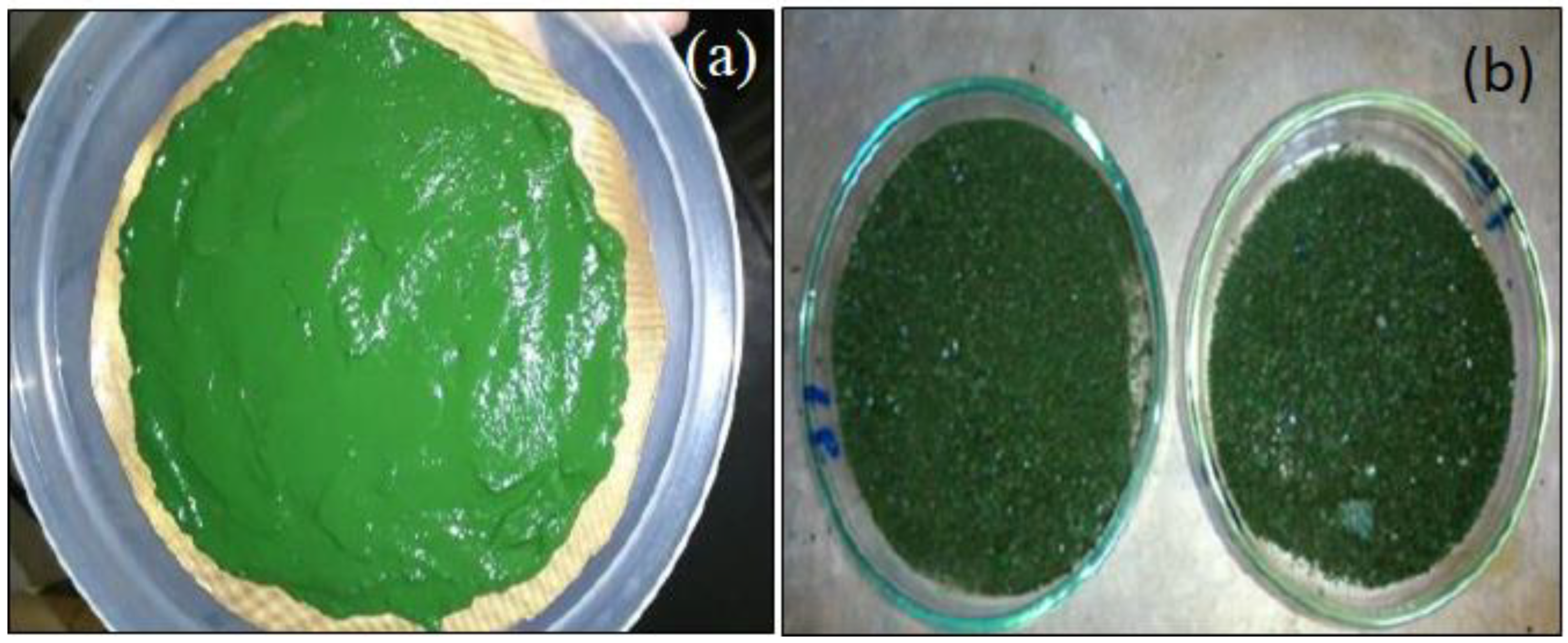
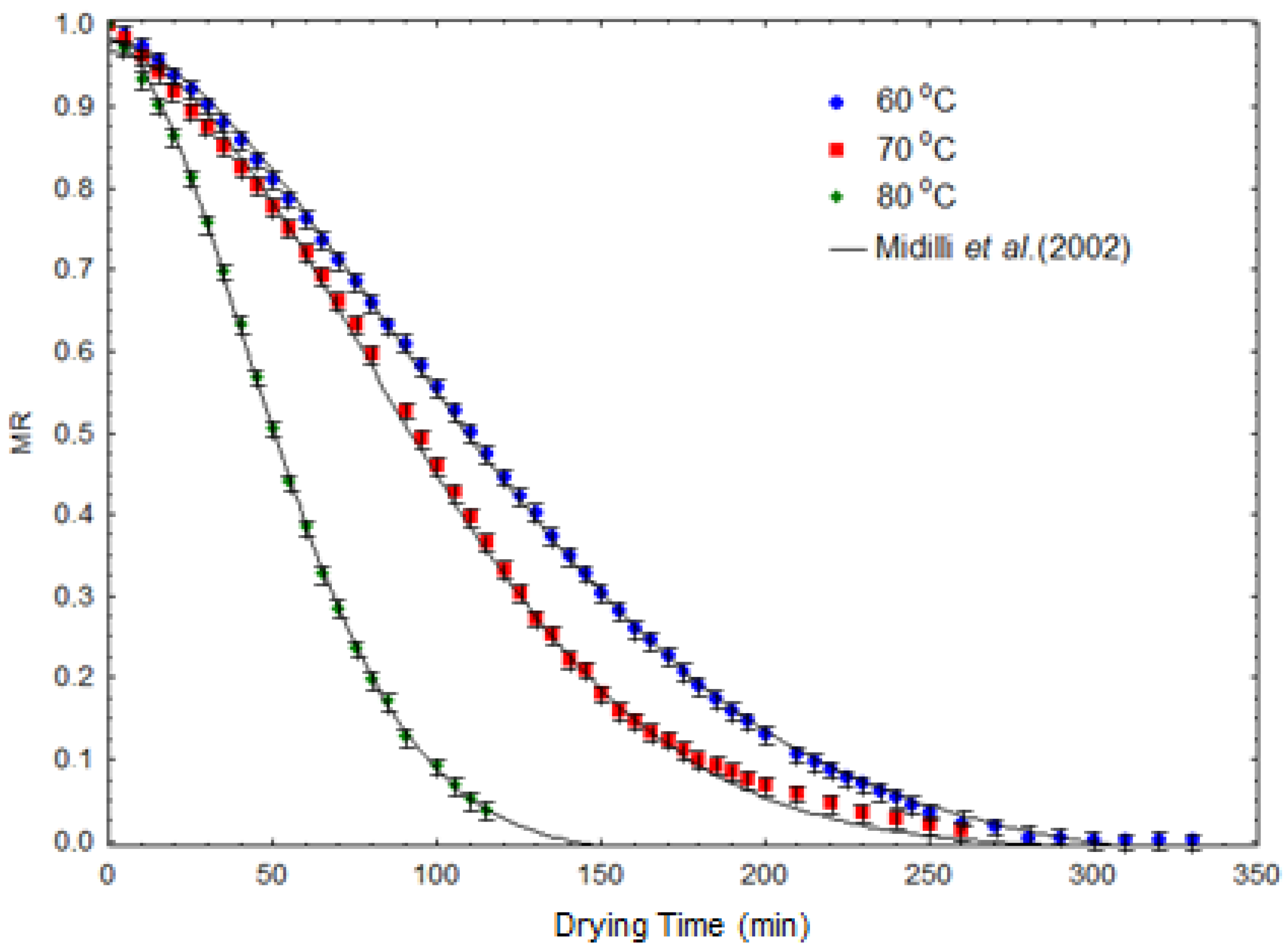
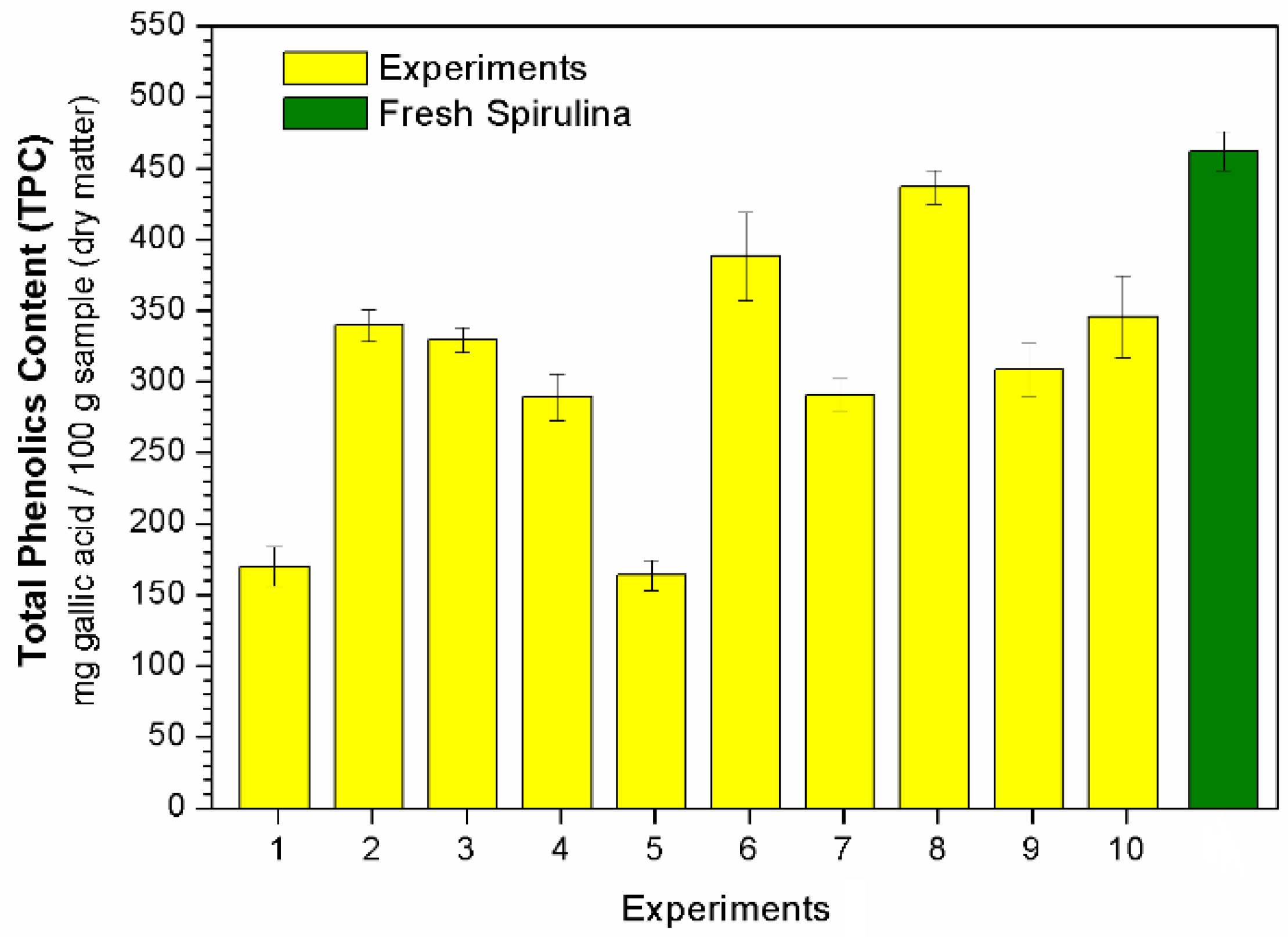
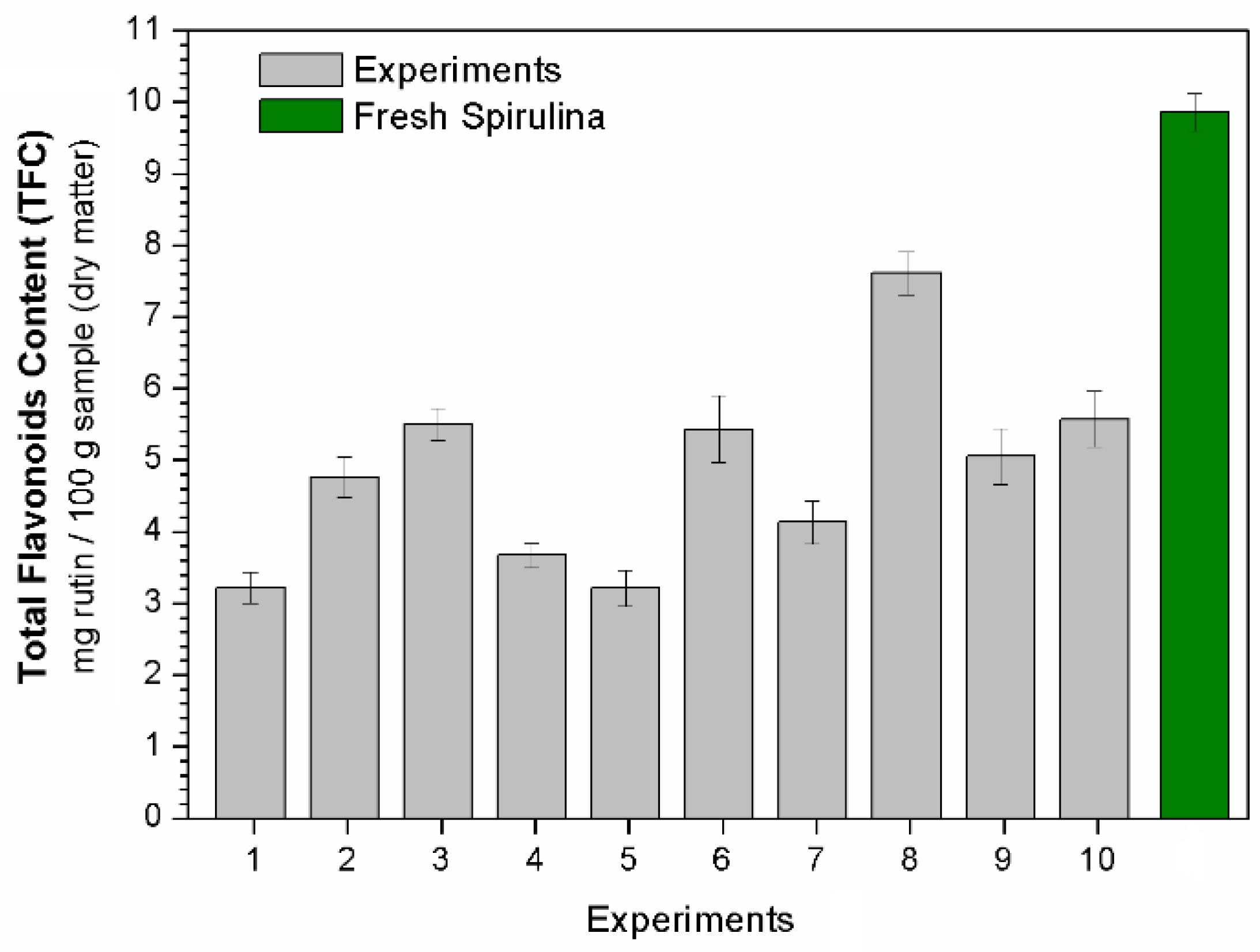
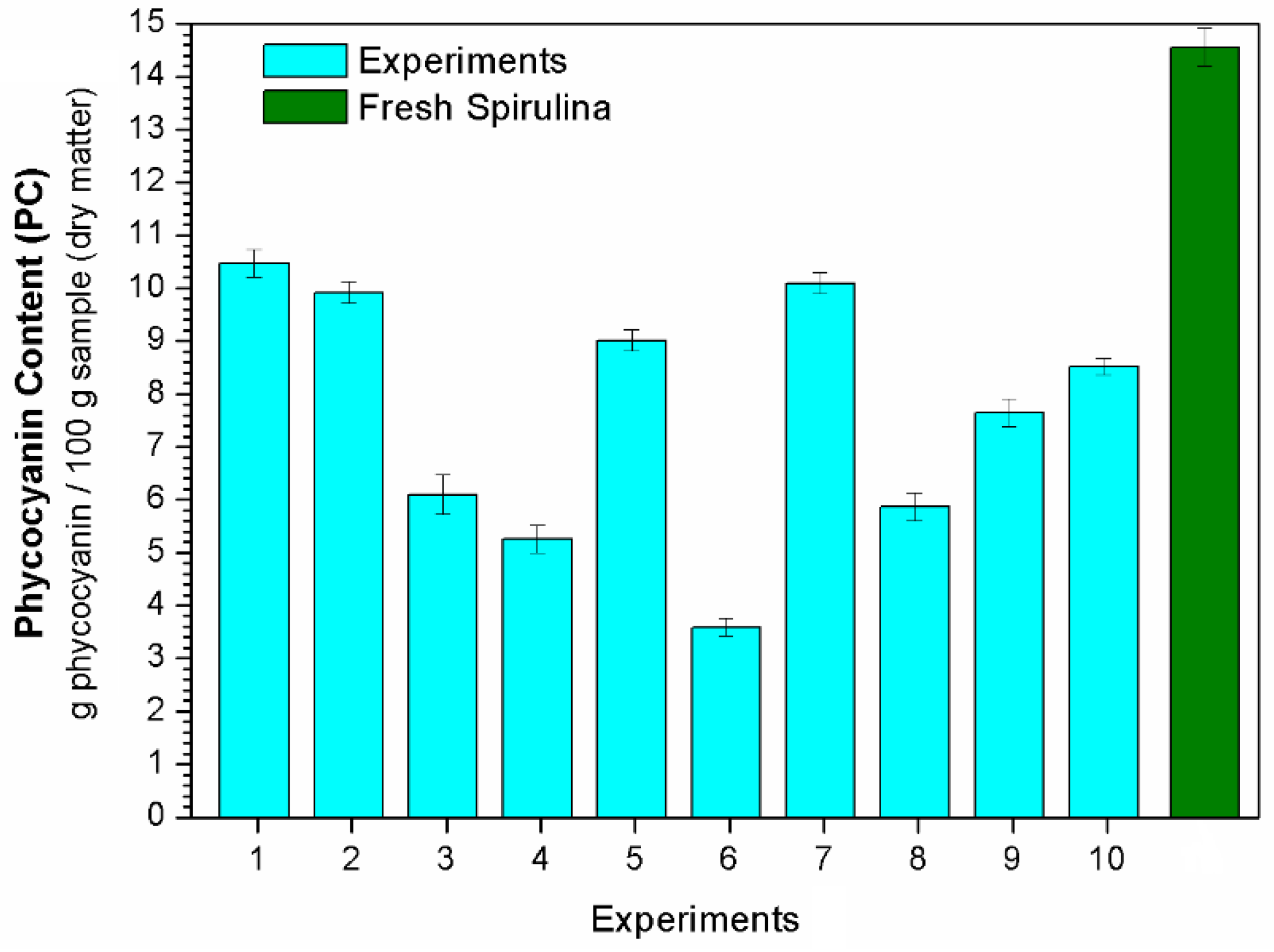
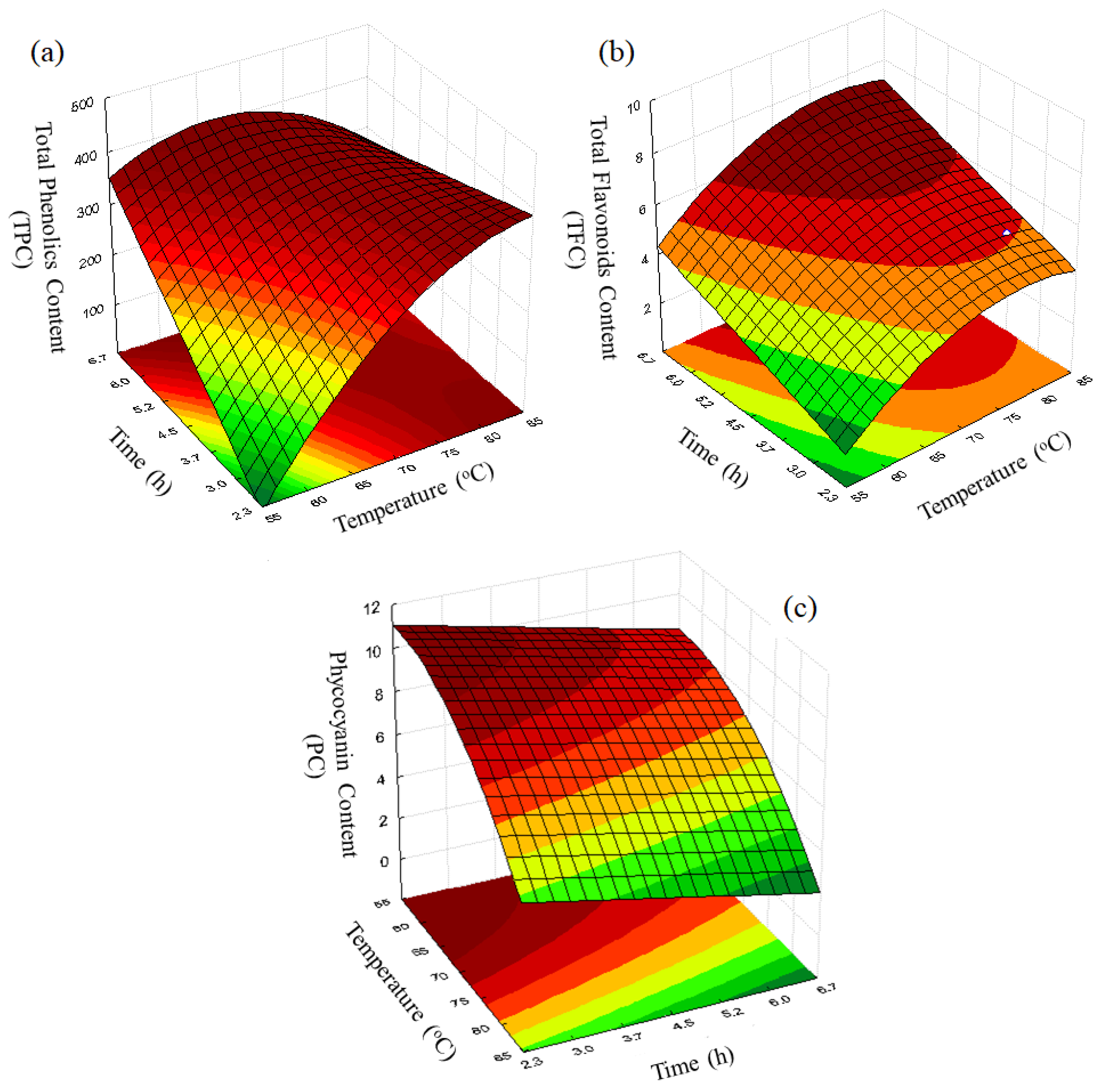
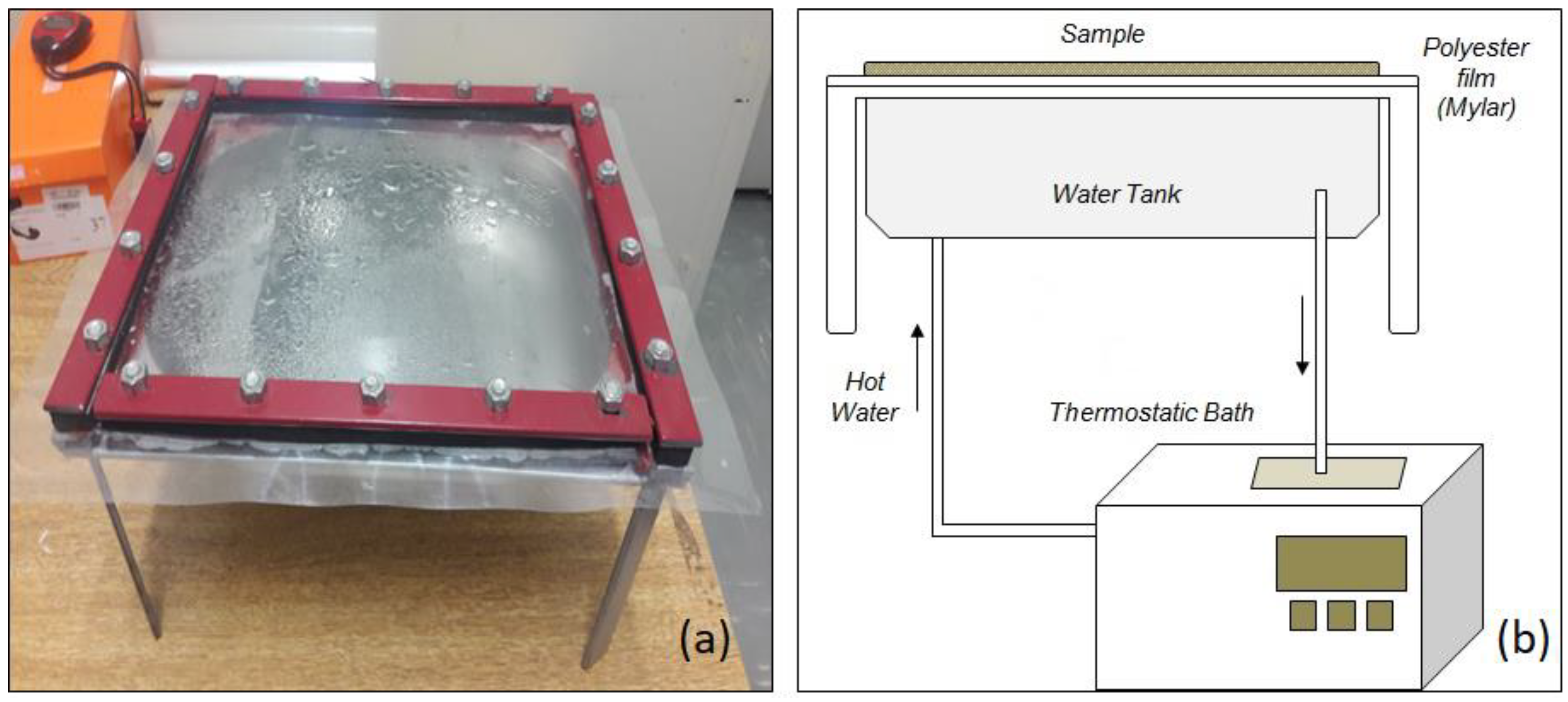
| Exp. | Temperature | Moisture (%) | Water Activity (aw) | Drying Time (min) |
|---|---|---|---|---|
| 1 | 60 °C | 13.04 ± 0.57% | 0.588 | 330 |
| 2 | 70 °C | 12.11 ± 0.30% | 0.474 | 260 |
| 3 | 80 °C | 10.15 ± 0.07% | 0.452 | 115 |
| Fresh Spirulina | 82.70 ± 0.97% | 0.967 | - | |
| Experiment | k | n | A | B | R2 |
|---|---|---|---|---|---|
| 60 °C | 2.00 × 10−4 | 1.72 | 0.9782 | −8.00 × 10−5 | 0.9996 |
| 70 °C | 3.42 × 10−4 | 1.77 | 0.9801 | −8.20 × 10−5 | 0.9990 |
| 80 °C | 5.36 × 10−4 | 1.82 | 0.9832 | −8.60 × 10−5 | 0.9997 |
| R2 medium | 0.9994 |
| Exp. | Temp. (T) °C | Time (t) h | Moisture (%) | Water Activity (aw) |
|---|---|---|---|---|
| 1 | 60.0 | 3.0 | 30.65 ± 0.16 | 0.829 |
| 2 | 60.0 | 6.0 | 13.60 ± 0.46 | 0.536 |
| 3 | 80.0 | 3.0 | 8.19 ± 0.19 | 0.367 |
| 4 | 80.0 | 6.0 | 8.06 ± 0.19 | 0.359 |
| 5 | 55.9 | 4.5 | 33.72 ± 0.02 | 0.839 |
| 6 | 84.1 | 4.5 | 7.06 ± 0.41 | 0.339 |
| 7 | 70.0 | 2.4 | 21.13 ± 0.51 | 0.694 |
| 8 | 70.0 | 6.6 | 12.17 ± 0.47 | 0.467 |
| 9 | 70.0 | 4.5 | 11.76 ± 0.42 | 0.418 |
| 10 | 70.0 | 4.5 | 10.73 ± 0.08 | 0.402 |
| Independent Variables | −1.414 | −1 | 0 | +1 | +1.414 |
|---|---|---|---|---|---|
| Temperature (°C) | 55.9 | 60.0 | 70.0 | 80.0 | 84.1 |
| Time (h) | 2.4 | 3.0 | 4.5 | 6.0 | 6.6 |
Disclaimer/Publisher’s Note: The statements, opinions and data contained in all publications are solely those of the individual author(s) and contributor(s) and not of MDPI and/or the editor(s). MDPI and/or the editor(s) disclaim responsibility for any injury to people or property resulting from any ideas, methods, instructions or products referred to in the content. |
© 2023 by the authors. Licensee MDPI, Basel, Switzerland. This article is an open access article distributed under the terms and conditions of the Creative Commons Attribution (CC BY) license (https://creativecommons.org/licenses/by/4.0/).
Share and Cite
Silva, N.C.; Freitas, L.V.D.; Silva, T.C.; Duarte, C.R.; Barrozo, M.A.S. Use of Refractance Window Drying as an Alternative Method for Processing the Microalga Spirulina platensis. Molecules 2023, 28, 720. https://doi.org/10.3390/molecules28020720
Silva NC, Freitas LVD, Silva TC, Duarte CR, Barrozo MAS. Use of Refractance Window Drying as an Alternative Method for Processing the Microalga Spirulina platensis. Molecules. 2023; 28(2):720. https://doi.org/10.3390/molecules28020720
Chicago/Turabian StyleSilva, Neiton C., Luis V. D. Freitas, Thaise C. Silva, Claudio R. Duarte, and Marcos A. S. Barrozo. 2023. "Use of Refractance Window Drying as an Alternative Method for Processing the Microalga Spirulina platensis" Molecules 28, no. 2: 720. https://doi.org/10.3390/molecules28020720
APA StyleSilva, N. C., Freitas, L. V. D., Silva, T. C., Duarte, C. R., & Barrozo, M. A. S. (2023). Use of Refractance Window Drying as an Alternative Method for Processing the Microalga Spirulina platensis. Molecules, 28(2), 720. https://doi.org/10.3390/molecules28020720







